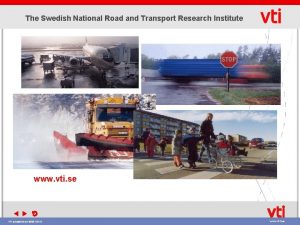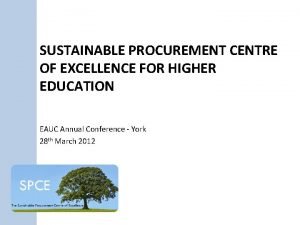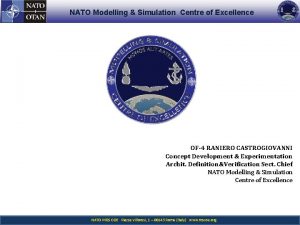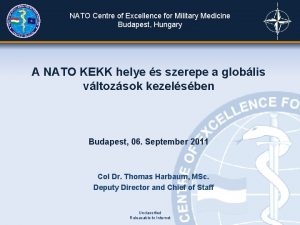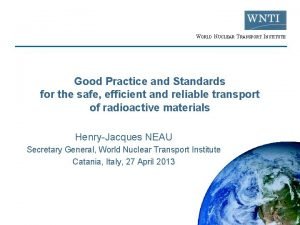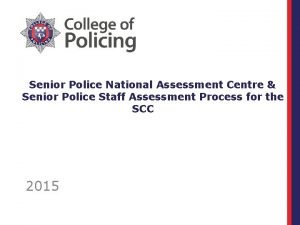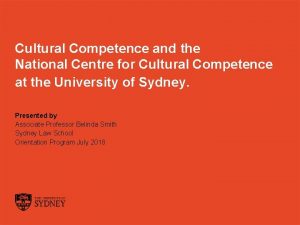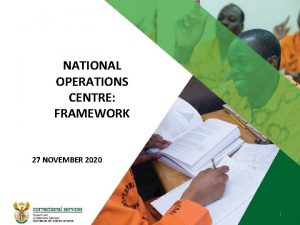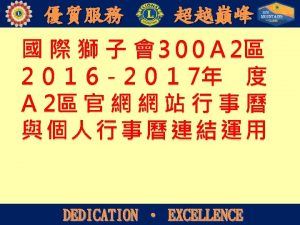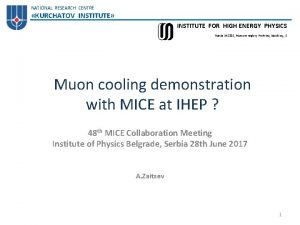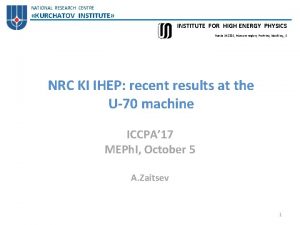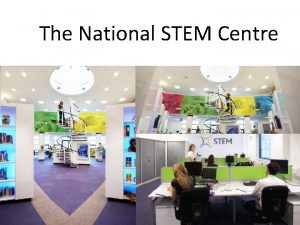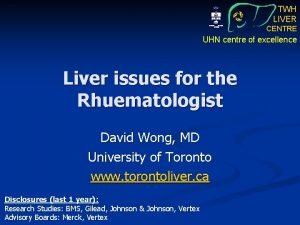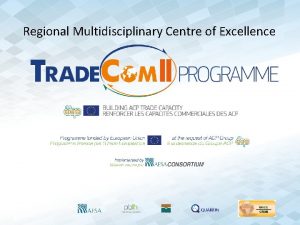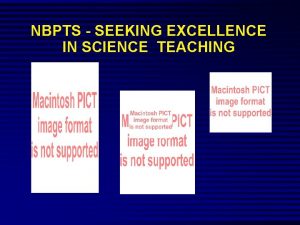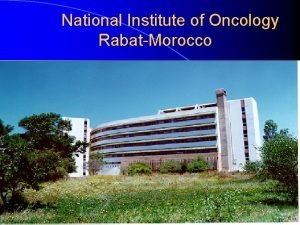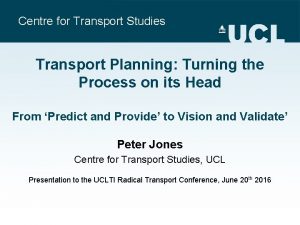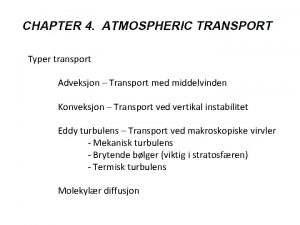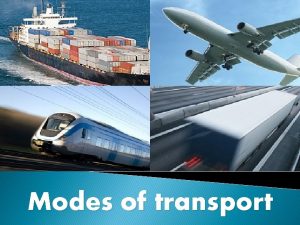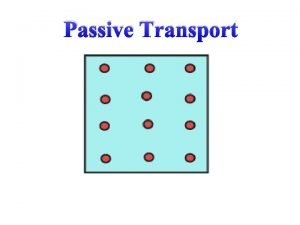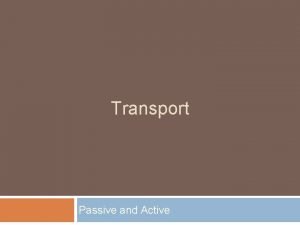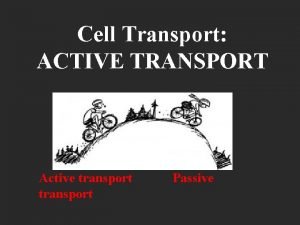National Institute of Transport Centre of Excellence in


























- Slides: 26

National Institute of Transport Centre of Excellence in Light Aircraft Operations June 04, 2018

Presentation contents 2 q Brief Information about NIT q Aspiration for NIT to become Centre of Excellence in LAO NIT – Centre of Excellence in LAO v Development Challenges v Co. E Objectives v Institutional Challenges v Overview of SIP q Sustainability q 9/15/2020

1. Brief Information about NIT 3 1. 1 Genesis of NIT 1975 Aim of establishment Established as training wing of then National Transport Corporation (NTC) NIT was charged with the responsibility of strengthening human resource capabilities of transport operatives and middle level managers of subsidiary companies of NTC

1. 1 Genesis of NIT cont’d 4 1982 Aim of re-establishment Re-established through NIT Act No. 24 of 1982 (Cap 187 revised edition 2002) as an autonomous Higher Learning Institution. Mandated to offer training in logistics, transport technology and other allied transport disciplines in all modes of transport (Road, Rail, Maritime, Air and Pipeline system)

1. 2 What Vision and Mission Entails to NIT 5 Vision Mission To be a Regional Centre of Excellence in Logistics, Management and Transport Technology To provide flexible and high quality education and training, research and consultancy in Logistics, management and Transport Technology for Sustainable Socio -economic development

1. 3 Departments/Units of the Institute with their respective programmes 6 S/N Name of Department ACADEMIC DEPARTMENT 1 Flying and Operations Management 2 3 Aeronautical Engineering Logistics and Transport Studies 4 Transport Technology 5 Business Studies 6 Computing Technology Engineering and Name of Programme i. Pilot (Private Pilot License-PPL) ii. Cabin Crew Aircraft Maintenance Engineering i. Logistics and Transport Management – Air Transport Management ii. Freight Clearing and Forwarding and i. Automobile Engineering ii. Mechanical Engineering Entrepreneurship i. iii. iv. Procurement and Logistics Management Accounting and Transport Finance Human Resource Management Marketing and Public Relations Communication i. Information and Technology ii. Computer Science 9/15/2020 Communication

1. 4 Aircraft Maintenance Facilities/ Equipment 7 Training aircraft for Aircraft maintenance engineering students Training hangar and aircraft/ helicopter engines for Aircraft maintenance engineering students

Pilot Training Facilities/ Equipment 8 Simulator for Training Pilots

1. 5 Students Enrolment And Staffing Capacity 9 For the last three years (2014/15 - 2016/17) a total of 15, 043 students enrolled, 80% are males and 20% are females In the last academic year 2016/17 a total of 1125 students graduated from various programs, 70% are males and 30% are females The Institute has a total of 145 instructors of which 97 (67%) are male and 48 (33%) are females 9/15/2020

2. Aspiration for NIT to become Co. E The aspiration of the NIT to become a Center of Excellence (Co. E) emanate from a number of factors 10 A combination of historical reasons that have lead NIT to evolve into a unique institution focused on meeting skills and technological needs (skilled workforce, research and consultancy) in transport sector The high priority accorded to transport sector within the development plans of Tanzania arising from its performance within the economy and the region The absence of an institution with similar capacity and 9/15/2020 expertise in transport logistics, management and technology

3. NIT – Centre of Excellence in LAO 11 3. 1 Development Challenges the Co. E Inspired to Solve Expansion of economic activity in agribusiness and energy all depend on increasing the capacity and efficiency in air transport Implementing big transport infrastructure development projects such as the revival of the national airline, Air Tanzania, to support the economic development initiatives needs skilled personnel in air transport operations 9/15/2020

3. NIT – Centre of Excellence in LAO 12 3. 1 Development Challenges the Co. E Inspired to Solve cont’d Increased demand of skilled aviation personnel as result of increased number of light aircrafts to serve the tourism and mining industry with in the country At the national level, the transport and logistics sector has been allotted high priority in the National Skills Development Strategy (NSDS) 9/15/2020

3. NIT – Centre of Excellence in LAO 13 3. 2 Specific objectives of the Co. E Increase the number and update/upgrade skills of aviation and logistic professionals; Provide highly trained experts for conducting training and research in air transport logistics and aviation subsectors; Facilitate establishment of collaborations and linkages between the Institute and the Transport 9/15/2020 stakeholders/industry;

3. NIT – Centre of Excellence in LAO 14 3. 2 Objectives of the Centre of Excellence cont’d Provide state-of-the-art training and learning environment for transport sector; Provide Technical Assistance (TA) to stakeholders on issues pertaining air transport logistics and aviation subsectors Act as a one-stop centre for transport logistics and Light Aircraft operations database. 9/15/2020

3. NIT – Centre of Excellence in LAO 15 3. 3 Institutional challenges for achieving Co. E Objectives v Inadequate infrastructure and training facilities to effectively facilitate training. v Dynamic gap between training offered and industrial needs v Weak pedagogical innovation in delivery of transport studies v Nurturing of young instructors to cater for the retiring group of instructors and updating /upgrading of instructors’ skills and teaching techniques. 9/15/2020

3. NIT – Centre of Excellence in LAO 16 3. 3 Institutional challenges for achieving Co. E Objectives cont’d v Lack gender issues awareness at the Institute to both instructors and students in transport and logistics training v Lack of vibrant collaborations with stakeholders and weak regional integration v Lack of tracer studies of its graduates to access employability of our students after graduation. 9/15/2020

3. 4 Departments and Programs where the Co. E will built on 17 Aeronautical Engineering Flying and Operations Management Logistics and Transport Management

4. Strategic Investment Plan 18 This includes: q Strengthening governance and management q Institutionalizing industry linkages q Developing market relevant and competency based training programs q Training of school managers and teachers q Upgrading Key Training Facilities and Equipment q Outreaching and Support for non-Project 9/15/2020 National TVET

4. 1 Strengthening Governance and Management 19 q Training of Co. E management team q Development of Policies and strategic plans will include: Ø Strategic Implementation Plan (SIP), Ø Co. E excellence operationalization policy, Ø Co. E sustainability plan, Ø Review of the NIT Five Year Strategic Rolling Plan Ø Gender Management Unit Policy. 9/15/2020

4. 2 Institutionalizing Industry Linkages 20 q Strengthen the Industrial Liaison and Carrier Guidance Unit q Establish Institute programs advisory committees q Enhance engagement of industry in provision of training (signing Mo. Us etc) q Carry out tracer studies to establish the employability of its graduates q Strengthening of the Alumni association. 9/15/2020

4. 3 Developing Market Relevant and Competency Based Training Programs 21 q Activities will include Ø Carryout Situation Analysis study (in country and region) Ø Developing five (5) new long programs Ø Review of existing five (5) long programs Ø Developing seven (7) new professional programs 9/15/2020

4. 4 Training of School Managers and Teachers 22 q q Train eight (8) academic staff in different Masters Degree programs Train fifteen (15) academic staff in different professional short courses Provide CBET based pedagogical techniques to NIT and aviation training institutions with in the country Train the institute administrative staff and Heads of department on management skills 9/15/2020

4. 5 Upgrading Key Training Facilities and Equipment 23 q Improvement of Infrastructure (construct): Ø Ø NIT-Co. E building, An aircraft hangar, A mock up building with a swimming pool A female students hostel q Facilities and Equipment Ø ICT training equipment and facilities Ø Pilot and transport Logistics simulators Computer Based Training programs Ø Two (2) aircrafts and cabin crew mock-up 9/15/2020 and

4. 6 Outreaching and Support for non-Project National TVET 24 q Provide professional training to stakeholders on programs such as fleet management and pilot simulator training q To provide access of transport database to other TVET training institutions q Provide pedagogical teaching techniques to other TVET institutions q To offer Master scholarships opportunities to the Master of Science in Air Transport Logistics and management at NIT to local and foreign students from related TVET institutions.

5. Sustainability 25 The NIT-Co. E plans to sustain itself by means of: Ø Attracting fees from external users to exploit training facilities and equipment available at the Co. E, Ø Increased income generation programs offered under the Co. E, Ø Consultancy and research offered by the Co. E from 9/15/2020 developed

Building the Youth for the Future 26 I thank you very much for your attention! 9/15/2020
 Cnesm
Cnesm Swedish national road and transport research institute
Swedish national road and transport research institute How to build a cloud center of excellence gartner
How to build a cloud center of excellence gartner Ibm centre of excellence
Ibm centre of excellence Baltic biomaterials centre of excellence
Baltic biomaterials centre of excellence Procurement centre of excellence
Procurement centre of excellence Iom fa
Iom fa Centre for excellence in universal design
Centre for excellence in universal design M&s coe
M&s coe Nato energy security centre of excellence
Nato energy security centre of excellence Nato centre of excellence for military medicine
Nato centre of excellence for military medicine Symport antiport uniport
Symport antiport uniport Primary active transport and secondary active transport
Primary active transport and secondary active transport Passive transport vs active transport venn diagram
Passive transport vs active transport venn diagram Passive transport vs active transport venn diagram
Passive transport vs active transport venn diagram Endocytosis vs exocytosis
Endocytosis vs exocytosis Primary active transport vs secondary active transport
Primary active transport vs secondary active transport Bioflix activity membrane transport active transport
Bioflix activity membrane transport active transport Active and passive transport
Active and passive transport Bioflix activity membrane transport diffusion
Bioflix activity membrane transport diffusion World nuclear transport institute
World nuclear transport institute Centroid problems engineering mechanics
Centroid problems engineering mechanics Centroid of wire
Centroid of wire Orce assessment methodology
Orce assessment methodology Nsclsc
Nsclsc National centre for cultural competence
National centre for cultural competence National operations centre
National operations centre

